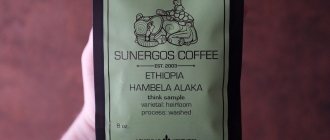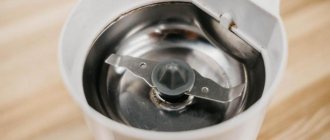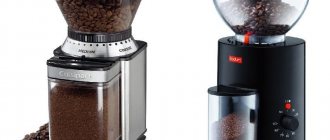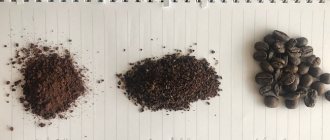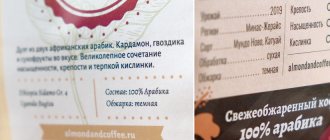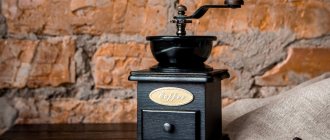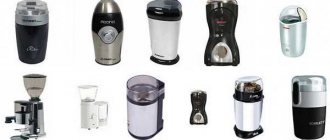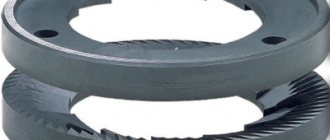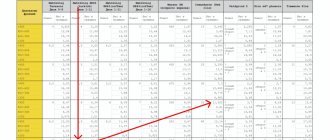After purchasing a professional coffee grinder, the company inevitably comes up with the question of correctly setting the coffee grinder for medium roast. Properly adjusted grinding is the basis for preparing espresso with a rich bouquet of taste and aroma. It is not always clear how to set the grinding correctly, but this important task does not require much time and effort if you follow a few rules.
Any barista knows that grinding affects the aroma and quality of the drink , so it is important for a coffee professional to be able to competently change the settings of a coffee grinder built into a coffee machine or standing alone. Without this, professional success of a barista is impossible. The choice of grinding is influenced by the method of brewing the drink and external factors: percentage of air humidity, room temperature, atmospheric pressure level. atmospheric conditions.
If you do not change the grind after the percentage of moisture in the air increases, the drink will become bitter because the particles swell, fit closer together and lengthen the brewing time of the coffee. In the case of a decrease in air humidity, the same mistake will lead to the appearance of an unpleasant sourness in the drink, since the coffee beans lose moisture, the distance between the particles becomes larger, and the extraction time of flavoring substances is shortened (not the entire bouquet of taste and aroma is boiled out of the grain).
When to change your coffee grinder settings
The coffee grinder settings must be changed in the following cases:
- Changing the type of coffee.
- If environmental conditions have changed: the air temperature has become higher or lower, the humidity level or atmospheric pressure has changed.
- If the coffee grinder knives have become dull (determined by uneven grinding). Knives require sharpening once a year.
There is no coffee grinder that will produce a completely uniform grind. In most cases, the ground beans will contain larger particles and coffee dust mixed in. To obtain high-quality coffee, you can sift the ground beans through a metal sieve of the required diameter to filter out particles that are too large or small.
When air humidity rises, coffee becomes bitter. As the humidity level decreases, it acquires a sour taste.
What is more important for grinding
Also check out these articles
- Modern blinds - main advantages
- Main types of insulation materials and their features
- What to look for when choosing a bouquet as a gift
- Interior decoration with posters
Coarse grinding of beans means the coffee will sour. Excessively fine grain - the drink will be bitter. The reason is not only the crushed product, but also the extraction. Selecting your standard - the amount of the mixture that is washed out of the powder with water. You can try it and see for yourself. Grind different types of coffee 5 times on 1 coffee grinder, the drink will give its own taste.
If the grain is ground too finely, the grains will become closer to each other as granules. It will be difficult for water to pass through the grains - the coffee will taste bitter. Large fractions of coffee after grinding will not be washed with a portion of adjusted water, which means the drink will begin to sour.
Rules for adjusting the grinding level
To select the desired degree of grinding, grind one portion of coffee, prepare espresso and measure the duration of extraction. If the drink is ready in 22 seconds or less, then it is recommended to make the grind finer; if the espresso is extracted for more than 28 seconds, increase it.
A professional coffee grinder is adjusted using a disk located under the hopper (a container for storing beans). To obtain a finer grind, rotate the disc towards the FINE inscription . This action can only be performed when the device is turned on. To make the grind coarser, turn the dial towards the COARSE inscription. You can increase the grind with the coffee grinder turned on and off.
One division unit on the disk is equivalent to 2-3 seconds of extraction. When adjusting the grind, it is important to remember that changing the grind does not change the other coffee settings. 7 grams of bean per single espresso (40 ml), pouring for 22-28 seconds. Correctly adjusted grinding will help to significantly save on grain consumption.
Be sure to read: Which professional carob coffee machines can be used at home
How to determine the dose for medium grind (for coffee ground into dust, add one to all numbers in the table):
| Unit of measure | Quantity, gram |
| Tea spoon | 4 |
| Heaped teaspoon | 6 |
| Tablespoon | 12 |
| Heaped tablespoon | 18 |
| Pinch | 0,5 |
| Matchbox "with a slide" | 6 |
To make delicious coffee, you need to use only freshly ground raw materials. The beans need to be ground 5-10 minutes before preparing espresso (or other coffee). Fresh coffee contains coffee oils that erode when exposed to air. If it is impossible to make freshly ground coffee every time, then the solution is to scatter the ground beans into different jars , 2-3 servings in each. In tightly closed containers, coffee will remain aromatic for 1-2 weeks.
Daniil Lobadin
Co-founder and head of the family manufactory Lobadin Coffee Roasters
Taking this opportunity, we repeat our favorite mantra: the grains need to be ground right before preparing the drink, do not stock up for a month in advance! It’s also great if a coffee lover has the opportunity to say goodbye to household blenders and blade coffee grinders: these machines produce an uneven grinding structure at the bean output, which means it’s not clear how to calculate the strength of the drink, and it’s not clear how to evaluate the taste of brewed coffee. But for the same or slightly more money that we would pay for a knife coffee grinder, you can buy a burr-type machine or a manual coffee grinder. Grinding the grains to the size of granulated sugar, ideally. Here, too, it is important to find a balance so as not to turn the entire supply of coffee into dust... well, here it is either a coffee grinder with a grinding level regulator, or practice-practice-practice.
— Daniil Lobadin Co-founder and head of the family manufactory Lobadin Coffee Roasters
Calibrate your grinder or grinding fines.
A long time ago, when coffee was just entering the life of mankind, the beans were pounded in a mortar and pestle. Using this method, it is almost impossible to achieve a fine grind, but to prepare traditional Ethiopian or Bedouin coffee, fine grinding was not required.
The grinding procedure was lengthy, required considerable force and did not provide the necessary grinding uniformity. Over time, the Arabs invented the first mechanical coffee grinder with a rotating handle . For more than five centuries, this mechanical product has not undergone significant changes. In 1665, the coffee grinder was improved by a London blacksmith, and it was patented only in 1798. April 3 is the birthday of Coffee Grinder.
Why adjust the grind?
Setting up a coffee grinder is an important, delicate and responsible moment. Coffee beans are very capricious, and ground coffee is even more capricious. Inhomogeneity of grinding, changes in humidity or temperature can lead to completely different results. Just had delicious coffee - and suddenly, out of the blue, or a sour, watery liquid, or a viscous, bitter and astringent liquid...
But they didn’t change the grinding! The coffee grinder was set up in the service department (in a store, a barista friend came to visit) a month (year) ago, and no one touched it! Common situation? Have you seen the touching naive stickers that say “Turk 3, espresso 4, filter 7”? So, none of this works. Correctly adjusted grinding can only happen here and now; yesterday’s settings are invalid.
The grind size is not a constant value, so it is impossible to adjust the coffee grinder once and for all.
Scared? Relax, this is only true for professional espresso grinders; home methods are less demanding. Let's figure out what the main grinding gradations are and how to adjust the grinding.
For each coffee preparation method, you need to select your own grind. The duration of brewing, temperature, pressure are also important... All these parameters need to be balanced so that from 18% to 25% of the soluble beneficial components found in the grain are transferred into the drink. This is 1.15 to 1.35 TDS (concentration of solids measured by a refractometer) as measured by the instruments in the cup. Then the coffee can be rich and tasty. There, in the central yellow square of the SCAE brew chart:
Very coarse grind: French press.
We use the coarsest grind for a French press (plunger, or French bistro coffee maker). The particle size should be about 0.8 mm. With coarse grinding, the extraction time (transfer of soluble substances into the drink) is 4 minutes. We can use medium-coarse grinding for this brewing method, but then we reduce the time to 3 minutes. If you follow these rules, your coffee will be great.
Coffee, properly brewed in a French press, retains the maximum of beneficial, flavoring and aromatic substances. This coffee has a dense body, a buttery richness of oils, and a great aroma. Many professionals use a French press in order to properly evaluate all the flavor and aromatic features of the grain.
Coarse grind: filter coffee makers.
“Coffee for cupping should be ground so that 70-75% remains on a number 20 sieve, with an opening diameter of 850mμ.” © Specialty Coffee Cupping Protocols
The second place in terms of particle size is occupied by a filter machine, a drip coffee maker. A lot of coffee is brewed, the temperature is high, the result is expected as soon as possible. Everything is logical. Very tasty coffee, by the way. The main thing is delicious, fresh Arabica, and not an espresso mixture pre-ground six months ago at the factory from the nearest supermarket.
The same grinding fineness is used when brewing coffee using the open method in a cup using the Brazilian system. It is the Brazilian cupping and filter that are used as the basis for all coffee tastings. This is perhaps the most canonized and well-documented grinding and brewing standard; refer to the regulations of COE, WCE, SCAE, SCAA.
Do you brew coffee in a cup at home? Do it like the entire coffee elite of the planet does! 5.5 g of coffee per 100 ml of unboiled water 92°C, brew for 4 minutes, remove the layer of coffee from the surface with a spoon, drink without sugar.
Medium-coarse grind: pour-overs of all stripes.
Of all the pourovers, the coarsest grind is usually used for Chemex and Clever, as they contain infusion elements, which increases extraction. The Chemex has very thick filter paper, so the coffee pours out slowly. Clover generally fixes the water in the funnel with a special valve. That is why not everyone considers these two devices to be the pour-over method. That’s what they write on the menu: “Chemex XX coins; Purover of XX coins.” And everything is clear to everyone.
The most popular pourovers are Hario V60, Melitta, Kalita Wave. Hario is especially popular, I'm not original, I also like him the most. Or maybe it's just a matter of habit. Alternative methods of brewing coffee allow for quite large variations in profiles, the main thing is that it is tasty. Different shapes of funnels and technology for folding filters, different coffees, different tastes - all this leaves an imprint on the grind size. There is room for creativity here! We increase the temperature - increase the grinding, lower the temperature - reduce the grinding. For large funnels, the grind is usually coarser than for small ones.
Approximately the same medium-coarse degree of grinding is usually used for siphons, although many experts argue that siphons like coarse grinding, as for cupping. The same applies to all drippers with fabric and metal filters; in order to get a clean drink without sediment, the grind should be coarser, as for cupping or French. Those who like it stronger make the grind finer, as with V60.
Medium grind: for all occasions.
It’s not for nothing that marketing specialists call this grinding universal. It can be used for a geyser-type coffee maker (moka), most inexpensive home manual espresso machines (carob coffee makers).
Aeropress likes a grind coarser than espresso, but finer than pour over. At the same time, it has a fairly wide field for experiments with time, temperature and grinding fineness. We check the correctness of the selected grinding by extraction. If the drink turns out rich and tasty, everything is OK.
Almost all coffee that is sold ground has just such an average grind. Therefore, the vast majority of coffee lovers use this type of coffee always and everywhere: in a filter coffee maker, in a Turkish coffee pot... and, of course, in a cup. This, of course, is wrong and tasteless. But this is life! And she is imperfect.
How to measure a dose of coffee
Ways to measure the right amount of coffee beans:
- Approximately. Unreliable method for beginners. Experienced baristas are able to measure the dose by eye without serious error. Exact dosage is not possible with this option.
- With the click of a coffee hopper. The coffee grinder has an error of 0.2 grams, so the dosage will remain inaccurate and will vary from portion to portion.
The ideal solution for weighing grain before grinding is to use an accurate scale with 0.1 gram increments for this purpose. You can buy inexpensive scales at a jewelry store or specialty coffee shops that are specifically designed for weighing coffee.
You should not try to artificially speed up the process of grinding coffee beans: if you do it too quickly, the grains will be too uneven, which will spoil the taste of the coffee. In addition, quickly ground coffee can heat up, resulting in a bitter drink with a burnt rubber taste .
If you follow all the instructions for proper grinding of beans, you will get coffee with excellent taste characteristics, which guests of the establishment will appreciate. And this will also reduce the consumption of coffee for preparing drinks.
Be sure to read: What water should you use in your coffee shop?
How does a coffee grinder work in a coffee machine?
The coffee grinder has a hopper for storing grain, a millstone block where it is ground and a container where the ground powder goes. Under the hopper there is usually a switch that operates when the device is turned on.
The grind setting of the espresso grinder is adjusted by adjusting the rotary switch. The more divisions, the more possibilities for preparing drinks and using different varieties. Many professional baristas know that the same variety, ground on the same device, produces a different taste. The fact is that some built-in coffee grinders have a limited number of grinding levels.
Setting up a coffee machine with a built-in coffee grinder begins with setting up the coffee grinder. It is not recommended to roast the beans too strongly while using fine powder. This gives the drink a bitter taste, if it even appears in the cup.
The fact is that too small particles stick to each other and prevent the passage of liquid between them. Water is absorbed into the coffee tablet and does not come out. In this case, you need to adjust or configure the Delonghi, Saeco, Nespresso coffee machine - those that have an automatic supply of ground powder.
Before setting up, you need to examine the condition of the coffee tablet, which is located in the waste container. It should be dense and not crumble.
How to Set Up a Manual Burr Coffee Grinder
Coffee grinders are divided into two large groups: manual and electric.
Electric coffee grinders operate using an electric motor and grind the beans using sharp knives.
Manual coffee grinders have a built-in burr mechanism. Millstones are made from ceramic or metal. The grinding process is done manually. The burrs are driven by a handle that is usually attached to the top of the grinder.
A manual coffee grinder is simpler than an electric one: it does not have a motor. But burr coffee grinders provide more uniform grinding and do not heat the coffee, so they are valued higher. In a burr coffee grinder, you can easily change the degree of grinding by changing the distance between the millstones. The downside of this device is the grinding speed. An electric coffee grinder handles beans many times faster than a manual one.
We tell you how to change the grinding degree of grain in a manual coffee grinder equipped with conical millstones.
To change the degree of grinding of coffee beans, the position of the upper millstone is changed; another name for it is “runner”. The lower millstone cannot be rotated!
Moving the runner upward makes the distance between the millstones larger and increases the size of the ground grains.
To reduce the distance between the millstones and make the grind finer, the slider is moved down. It is important not to make the distance too small: this will cause the millstones to wear out quickly and may jam.
Algorithm for moving the runner:
- Remove the handle by unscrewing the nut that secures it.
- Remove the washer.
- Unscrew or tighten the adjusting nut, depending on whether you need to make the grind finer or coarser.
- Return the washer and other elements to their original position.
How to configure
Setting the coffee grind is carried out with the coffee machine turned on so that the unit can make changes to its electronic memory. The switch cannot be turned when the device is turned off.
How to adjust the coffee grind on a coffee grinder or the extraction time:
- Turn on the car.
- Brew a test shot of espresso to determine the extraction time. When brewing 7 g of powder, it should be in the range of 22 to 28 seconds. This degree is considered correct.
- If the extraction lasts less than 22 seconds, turn the dial towards a finer grind. Each division increases the time by 2 - 3 seconds.
- If brewing takes more than 28 seconds, turn the switch towards a finer grind. The designations Fine or Gros indicate fine or coarse, respectively.
How to reduce coffee consumption in a coffee machine: set a finer level so that a smaller amount of beans gives more flavor with the same water levels.
Video: Lesson from a barista on setting the grind
In a manual coffee grinder, to increase or decrease the degree of grinding, you need to change the distance between the millstones. Before setting a manual coffee grinder to the finest grind, you need to know that in this position it will be more difficult for the millstones to work and they may jam.
Cunill Tranquilo TRON: adjusting grinding and working with settings
Setting up the Cunill Tranquilo TRON coffee grinder is distinguished by the ability to finely adjust the grind size. The size of the dispensed portion varies from 5 to 12 grams, which allows you to save grain consumption.
The device allows you to set the dose for single and double portions. It is possible to program a third dose option - individual.
The finest grind is ideal for making coffee in a cezve. The coffee grinder does an excellent job of grinding espresso. The ground grains do not clump, the grinding is uniform.
A coarse grind for French press or alternative methods is also highly commendable. The particle diameter is about 3 mm, the grinding is uniform, without dust or other defects.
The coffee grinder gently grinds coffee beans and does not break them, as cheap machines with imitation millstones do. Coffee retains its aroma.
Coffee ground in this machine retains its natural aroma, does not lose its richness, and does not acquire impurities. This characteristic is important for any brewing and grinding method: French press, filter, espresso or cezve.
All of the above advantages are only relevant if you use the highest quality coffee beans. Coffee must be roasted in compliance with all rules, and green beans must meet quality standards.
Description and principle of operation
A coffee grinder, as its name suggests, is designed for grinding coffee beans. The degree of grinding has a huge impact on the taste of the drink.
The grind size is a constantly changing value. It is impossible to set up a coffee grinder once and for all. Coffee beans and the grinding product are very sensitive to temperature and humidity. From the same raw materials, a product with different tastes is obtained.
Air humidity, temperature and pressure affect the grinding state. At high humidity, the drink will become bitter: coffee particles absorb moisture from the air, swell, and extraction deteriorates. Dry air leads to the opposite effect: the drink begins to sour. But what inexpensive electric coffee grinders there are and how to choose the one you need is described in great detail here.
The video shows how the coffee grinder works:
Grinding calibration depending on external conditions:
- Enlargement of particles with increasing humidity, decreasing temperature and pressure.
- The drier the air, the higher the pressure and temperature, the smaller the fractions.
You can determine the quality of the resulting product visually: use a stopwatch to measure the espresso preparation time. Drink preparation in 25 seconds. means good quality. Time interval less than 22 seconds. and more than 28 sec. means, in the first case, coarse grinding, in the second - too fine.
But which coffee maker is better, geyser or drip, and what parameters should be used to select them, this information will help you understand.
Grinding scale gradation for electric grinders:
- 30-34 – for French presses (the largest);
- 27-29 – vacuum coffee makers;
- 14-26 – drip (automatic and mechanical);
- 9-13 – Aeropress;
- 5-8 – espresso;
- 1-4 – coffee makers for Turkish coffee (the smallest).
The history of a mechanical coffee grinder goes back 5 centuries, and has not undergone significant design changes since then.
A manual coffee grinder resembles a miniature mill. One millstone is fixedly fixed in the body, the second is located above the first and grinds the coffee beans. The crushed grains fall into a container located under the millstones. The gap between the millstones is set manually. By rotating the handle, the grains are crushed using mechanical energy.
But how to choose an electric coffee grinder for your home and what parameters can be set out in this article.
